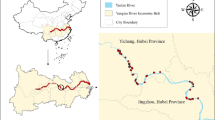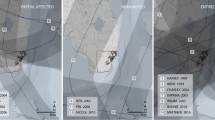Abstract
Whether people perceive and respond to low-probability natural hazards is a research question of considerable policy relevance. We obtain evidence by considering the response of housing choice to tornado risk for manufactured homes. The vulnerability of manufactured housing, combined with its growing share of the U.S. housing market, has led to proposed mandates for community shelters in mobile home parks. Expected utility theory, however, predicts that households should account for tornado risk in their housing choice. We test for an effect of tornado risk on manufactured housing demand using cross-sectional state data, as well as counties in three tornado prone states. We find that people do respond to tornado risk; our estimates indicate that each expected annual state tornado death per million residents reduces demand for manufactured homes by about 3%. The estimated quantity effect is consistent with the market studies of the price elasticity of manufactured homes.
Similar content being viewed by others
Notes
The National Weather Service uses the term “permanent homes” to refer to single family homes, duplexes, town homes, and apartments.
The source for all tornado records is a national archive of tornadoes since 1950 maintained by the Storm Prediction Center.
The cross-state correlation between Fatality Rate and Damage Area equals 0.82, which is high enough to consider the two measures compatible but not so high as to cause redundancy.
We also included in specifications not reported here the poverty rate and the Gini coefficient, but they did not attain significance or alter the inferences.
The two artificial regressors are the expectation of the latent index and the generalized residuals. Thus for the uncensored observations the variables consist of the fitted index and residuals from the Tobit model (8). For the censored observations, the generalized residuals equal−σuϕ(δ’W i /σu)/(1-Φ(δ’W i /σu)), where ϕ and Φ are respectively the standard normal density and distribution functions, and σu, δ’W i are evaluated at the Tobit estimates. To compute the expected index for the censored observations, subtract the generalized residual from the fitted index.
Note that the model in column (c) of Table 2 includes two endogenous variables (Fatality Rate and Relative Price), while the matrix W i uses three instruments: median home price, tornadoes per capita, and Damage Area. The model thus imposes one overidentifying restriction. A test of the restriction yields an asymptotic t-statistic equal to 1.01. The test therefore does not reject the instruments.
The estimates omit one exceptionally small Texas county due to incomplete data.
Relatively little is known about the location or severity of tornado injuries. Some rough calculations indicate that under any plausible assumptions the value of injuries is less than 10 percent of the value of fatalities. We therefore focus exclusively on fatalities.
Including the value of the state-median risk brings the full cost to $1,630.
References
American Meteorological Society. (1997). Policy statement: Mobile homes and severe windstorms. Bulleting of the American Meteorological Society, 78(5), 850–851.
Beron, K. J., Murdoch, J. C., Thayer, M. A., & Vijverberg, W. P. M. (1997). An analysis of the housing market before and after the 1989 Loma Prieta earthquake. Land Economics, 73(1), 101–13.
Brooks, H. E., & Doswell III, C. A. (2002). Deaths in the 3 May 1999 Oklahoma City tornado from a historical perspective. Weather and Forecasting, 17, 354–61.
Brookshire, D. S., Thayer, M. A., Tschirhart, J., & Schulze, W. D. (1985). A test of the expected utility model: Evidence from earthquake risks. Journal of Political Economy, 93(2), 369–389.
Camerer, C. F., & Kunreuther, H. (1989). Decision processes for low probability events: Policy implications. Journal of Policy Analysis and Management, 8(4), 565–592.
Carbone, J. C., Hallstrom, D. G., & Smith, V. K. (2006). Can natural experiments measure behavioral responses to environmental risks? Journal of Environmental Economics and Management, 33(3), 273–292.
Dash, N., & Gladwin, H. (2007). Evacuation decision making and behavioral responses: Individual and household. Natural Hazards Review, 8(3), 69–77.
De Alessi, L. (1996). Error and bias in benefit-cost analysis: HUD’s case for the wind rule. Cato Journal, 16(1), 129–147.
Golden, J. H., & Snow, J. T. (1991). Mitigation against extreme windstorms. Reviews of Geophysics, 29(4), 477–504.
Hallstrom, D. G., & Smith, V. K. (2005). Market responses to hurricanes. Journal of Environmental Economics and Management, 50(3), 541–561.
Kahneman, D., & Tversky, A. (1979). Prospect theory: An analysis of decision under risk. Econometrica, 47, 263–292.
Krantz, D. H., & Kunreuther, H. C. (2007). Goals and plans in decision making. Judgment and Decision Making, 2(3), 137–168.
Kunreuther, H. (1978). Disaster insurance protection: Public policy lessons. New York: Wiley.
Kunreuther, H. (1996). Mitigating disaster losses through insurance. Journal of Risk and Uncertainty, 12, 171–187.
Kunreuther, H., & Kleffner, A. (1992). Should earthquake mitigation measures be voluntary or required? Journal of Regulatory Economics, 4, 321–335.
Kunreuther, H., & Pauly, M. (2004). Neglecting disaster: Why don’t people insure against large losses? Journal of Risk and Uncertainty, 28(1), 5–21.
Kunreuther, H., Novemsky, N., & Kahneman, D. (2001). Making low probabilities useful. Journal of Risk and Uncertainty, 23(2), 103–120.
MacDonald, D. N., Murdock, J. C., & White, H. L. (1987). Uncertain hazards, insurance, and consumer choice: Evidence from housing markets. Land Economics, 63, 361–371.
McClelland, G. H., Schulze, W. D., & Coursey, D. L. (1993). Insurance for low-probability hazards: A bimodal response to unlikely events. Journal of Risk and Uncertainty, 7, 95–116.
Marshall, M. I., & Marsh, T. L. (2007). Consumer and investment demand for manufactured housing units. Journal of Housing Economics, 16, 59–71.
Meeks, C. B. (1995). Manufactured Home Life. Arlington, VA: Manufactured Housing Institute.
Merrell, D., Simmons, K. M., & Sutter, D. (2005). The determinants of tornado fatalities and the benefits of tornado shelters. Land Economics, 81(1), 87–99.
Meyer, R. J. (2006). Why we under-prepare for hazards. In R. J. Daniels, D. F. Kettl, & H. Kunreuther (Eds.), On Risk and Disaster. Philadelphia: University of Pennsylvania Press.
Palm, R. (1998). The demand for disaster insurance: Residential coverage. In H. Kunreuther & R. J. Roth Sr. (Eds.), Paying the Price. Washington DC: Joseph Henry Press.
Schmidlin, T., Hammer, B., King, P., Ono, Y., Miller, L. S., & Thumann, G. (2002). Unsafe at any (wind) speed? Testing the stability of motor vehicles in severe winds. Bulletin of the American Meteorological Society, 83(12), 1821–1830.
Schmidlin, T. W., Hammer, B., & Knabe, J. (2001). Tornado shelters in mobile home parks in the United States. Journal of the American Society of Professional Emergency Planners, 8, 1–15.
Shilling, J. D., Benjamin, J. D., & Sirmans, C. F. (1985). Adjusting comparable sales for floodplain location. Appraisal Journal, 53, 429–436.
Simmons, K. M., & Sutter, D. (2007). Tornado shelters and the manufactured home parks market. Construction Management and Economics, 25(11), 1119–1126.
Simmons, K. M., Kruse, J. B., & Smith, D. A. (2002). Valuing mitigation: real estate market response to hurricane loss measures. Southern Economic Journal, 68(3), 660–671.
Smith, V. K., Carbone, J. C., Pope, J. C., Hallstrom, D. G., & Darden, M. (2006). Adjusting to natural disasters. Journal of Risk and Uncertainty, 33(1/2), 37–54.
Spreyer, J. F., & Ragas, W. R. (1991). Housing prices and flood risk: An examination using spline regression. Journal of Real Estate Finance and Economics, 4, 395–407.
Vella, F. (1993). A simple estimator for simultaneous models with censored endogenous regressors. International Economic Review, 34(2), 441–457.
Viscusi, W. K., & Aldy, J. E. (2003). The value of a statistical life: A critical review of market estimates throughout the world. Journal of Risk and Uncertainty, 27(1), 5–76.
Viscusi, W. K., & Zeckhauser, R. J. (2006). National survey evidence on disasters and relief: Risk beliefs, self-interest, and compassion. Journal of Risk and Uncertainty, 33(1/2), 13–36.
Acknowledgments
We thank the editor and two anonymous referees for helpful comments. An earlier draft of this paper was presented at the Southern Economics Association meetings. Harold Brooks and Brent McAloney of NOAA for supplying us with the data on tornado fatality locations.
Author information
Authors and Affiliations
Corresponding author
Rights and permissions
About this article
Cite this article
Sutter, D., Poitras, M. Do people respond to low probability risks? Evidence from tornado risk and manufactured homes. J Risk Uncertain 40, 181–196 (2010). https://doi.org/10.1007/s11166-010-9087-8
Published:
Issue Date:
DOI: https://doi.org/10.1007/s11166-010-9087-8




